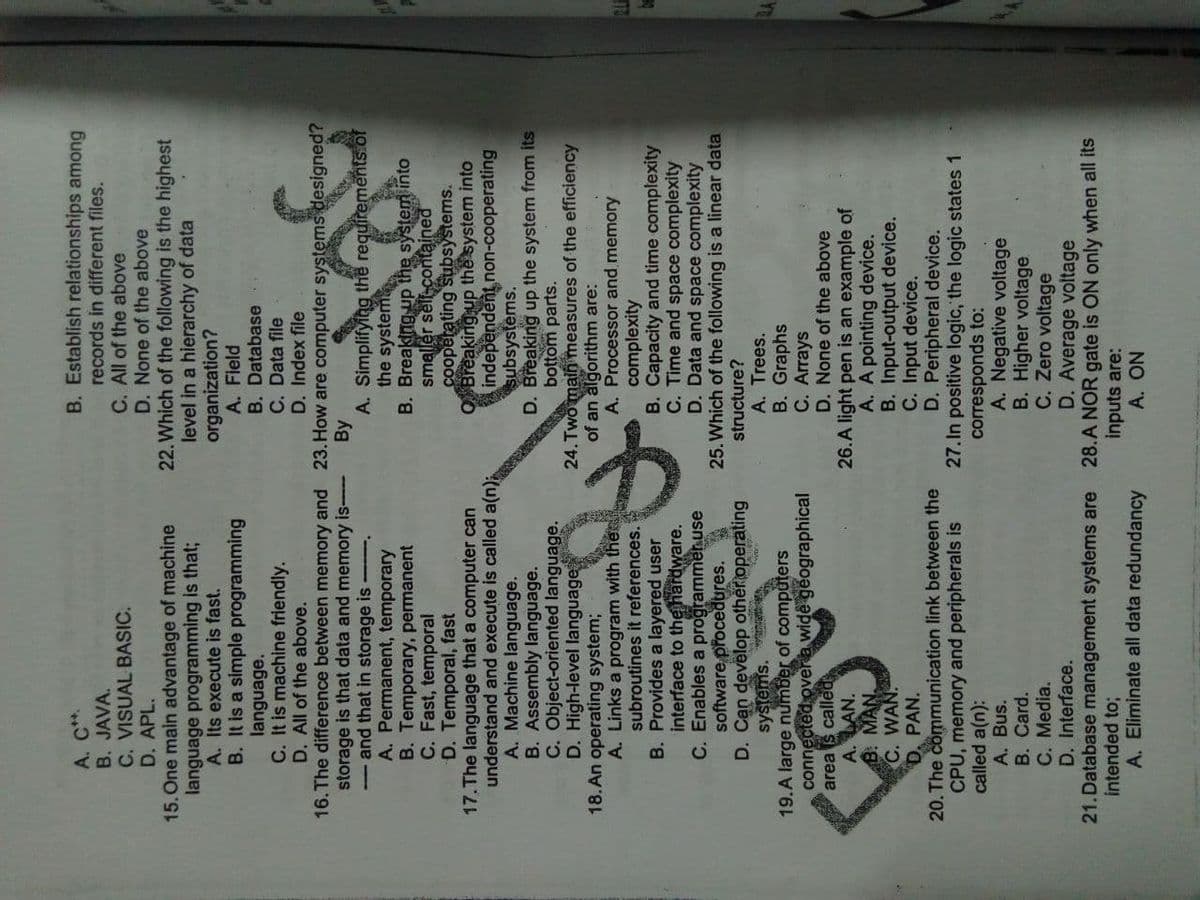B. Assembly language. C. Object-oriented language. D. High-level language 18. An operating system; A. Links a program with the subroutines it references. B. Provides a layered user interface to the hardware. C. Enables a programmenuse software procedures. D. Can develop other operating systems. 19.A large number of compoters connected overa wide geographical area s called A. LAN. B. MAN C. WAN D. PAN. 20. The communication link between the CPU, memory and peripherals is called a(n): A. Bus. B. Card. C. Media. D. Interface.
B. Assembly language. C. Object-oriented language. D. High-level language 18. An operating system; A. Links a program with the subroutines it references. B. Provides a layered user interface to the hardware. C. Enables a programmenuse software procedures. D. Can develop other operating systems. 19.A large number of compoters connected overa wide geographical area s called A. LAN. B. MAN C. WAN D. PAN. 20. The communication link between the CPU, memory and peripherals is called a(n): A. Bus. B. Card. C. Media. D. Interface.
Database System Concepts
7th Edition
ISBN:9780078022159
Author:Abraham Silberschatz Professor, Henry F. Korth, S. Sudarshan
Publisher:Abraham Silberschatz Professor, Henry F. Korth, S. Sudarshan
Chapter1: Introduction
Section: Chapter Questions
Problem 1PE
Related questions
Question
Answer question 18, 19, 20 showing fully all the steps. Solution should be perfect(very correct), clear, brief and explicit enough!

Transcribed Image Text:B. Establish relationships among
A. C*
B. JAVA.
C. VISUAL BASIC.
D. APL.
records in different files.
C. All of the above
D. None of the above
22. Which of the following is the highest
15. One main advantage of machine
language programming is that;
A. Its execute is fast.
B. It is a simple programming
language.
C. It is machine friendly.
D. All of the above.
level in a hierarchy of data
organization?
A. Field
B. Database
C. Data file
D. Index file
16. The difference between memory and 23. How are computer systems designed?
storage is that data and memory is--
- and that in storage is --
A. Permanent, temporary
B. Temporary, permanent
C. Fast, temporal
D. Temporal, fast
By
A. Simplifying thể requirements of
the system
B. Breaking up the system into
smaller self contained
cooperating subsystems.
OBreaking up the system into
independent non-cooperating
subsystems.
D. Breaking up the system from its
bottom parts.
24. Two main measures of the efficiency
of an algorithm are:
A. Processor and memory
complexity
B. Capacity and time complexity
C. Time and space complexity
D. Data and space complexity
25. Which of the following is a linear data
structure?
A. Trees.
B. Graphs
C. Arrays
D. None of the above
26.A light pen is an example of
A. A pointing device.
B. Input-output device.
C. Input device.
D. Peripheral device.
27. In positive logic, the logic states 1
corresponds to:
A. Negative voltage
B. Higher voltage
C. Zero voltage
D. Average voltage
28.A NOR gate is ON only when all its
inputs are:
A. ON
17.The language that a computer can
understand and execute is called a(n);
A. Machine language.
B. Assembly language.
C. Object-oriented language.
D. High-level language
18. An operating system;
A. Links a program with the
subroutines it references.
B. Provides a layered user
interface to thehardware.
C. Enables a programmeruse
software procedures.
D. Can develop other operating
sysjems. an
19.A large number of computers
connected overa wide geographical
area s called
A. LAN.
MAN
C. WAN.
D. PAN.
20. The communication link between the
CPU, memory and peripherals is
called a(n):
A. Bus.
B. Card.
C. Media.
D. Interface.
21. Database management systems are
intended to;
A. Eliminate all data redundancy
Expert Solution
This question has been solved!
Explore an expertly crafted, step-by-step solution for a thorough understanding of key concepts.
Step by step
Solved in 3 steps

Knowledge Booster
Learn more about
Need a deep-dive on the concept behind this application? Look no further. Learn more about this topic, computer-science and related others by exploring similar questions and additional content below.Recommended textbooks for you

Database System Concepts
Computer Science
ISBN:
9780078022159
Author:
Abraham Silberschatz Professor, Henry F. Korth, S. Sudarshan
Publisher:
McGraw-Hill Education

Starting Out with Python (4th Edition)
Computer Science
ISBN:
9780134444321
Author:
Tony Gaddis
Publisher:
PEARSON

Digital Fundamentals (11th Edition)
Computer Science
ISBN:
9780132737968
Author:
Thomas L. Floyd
Publisher:
PEARSON

Database System Concepts
Computer Science
ISBN:
9780078022159
Author:
Abraham Silberschatz Professor, Henry F. Korth, S. Sudarshan
Publisher:
McGraw-Hill Education

Starting Out with Python (4th Edition)
Computer Science
ISBN:
9780134444321
Author:
Tony Gaddis
Publisher:
PEARSON

Digital Fundamentals (11th Edition)
Computer Science
ISBN:
9780132737968
Author:
Thomas L. Floyd
Publisher:
PEARSON

C How to Program (8th Edition)
Computer Science
ISBN:
9780133976892
Author:
Paul J. Deitel, Harvey Deitel
Publisher:
PEARSON

Database Systems: Design, Implementation, & Manag…
Computer Science
ISBN:
9781337627900
Author:
Carlos Coronel, Steven Morris
Publisher:
Cengage Learning

Programmable Logic Controllers
Computer Science
ISBN:
9780073373843
Author:
Frank D. Petruzella
Publisher:
McGraw-Hill Education